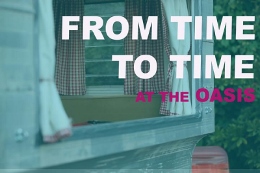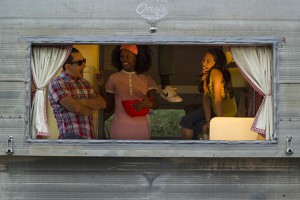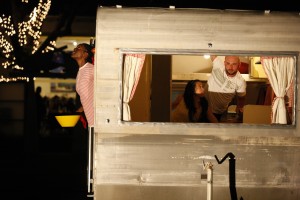HEIDI DUCKLER OFFERS AN OASIS FROM CONVENTIONAL DANCE
Well before her college-years dance training, Heidi Duckler danced as early as she could walk. “I’ve always been dancing,” she tells Stage and Cinema. “I went to Reed College. I went to Europe. I finally finished at the University of Oregon with a B.S. in Dance because that is all they offered at the time.”
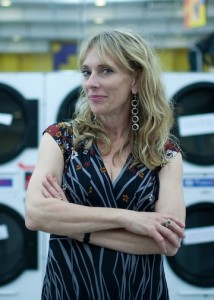 Although she started as a dancer, Duckler’s path to becoming a professional choreographer began when she applied for the M.A. program in dance at UCLA. She explains, “I wanted to be a part of the dance community in Los Angeles so I jumped in and applied to the program. I met a lot of interesting people and it was there that I decided to focus on making dances that were outside.”
Although she started as a dancer, Duckler’s path to becoming a professional choreographer began when she applied for the M.A. program in dance at UCLA. She explains, “I wanted to be a part of the dance community in Los Angeles so I jumped in and applied to the program. I met a lot of interesting people and it was there that I decided to focus on making dances that were outside.”
Duckler’s site-specific choreography’”that which is created for non-traditional theater spaces’”has been performed all over the world. For over twenty years she has created pieces in the most unconventional of places: East L.A.’s Linda Vista Hospital; a Laundromat; the Los Angeles River; and Perino’s Restaurant among others. Her most recent work From Time to Time’¦At the Oasis is no different. Of the inception, she states, “You always invest your time and energy in one place so I thought about creating a work that could literally be moved. Our Board of Directors purchased a 1961 Oasis trailer, nicknamed it the Duck Truck, and it provided us with a lot of opportunities.”
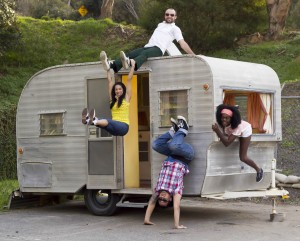 From Time to Time’¦At the Oasis is supported through Duckler’s participation in the Dance/USA’s Engaging Dance Audiences Program, which is funded through the Doris Duke Charitable Foundation. They are currently taking the Duck Truck on an engagement series through four California State University campuses: Fresno, the East Bay, Los Angeles, and Dominguez Hills. By taking the work to colleges, Duckler hopes to further investigate how to engage audiences. “We are also going to live-stream the show online as it is happening,” she explains. “We have never done that before and it will be interesting to talk to the students that participate through technology. I want to know what they experience.”
From Time to Time’¦At the Oasis is supported through Duckler’s participation in the Dance/USA’s Engaging Dance Audiences Program, which is funded through the Doris Duke Charitable Foundation. They are currently taking the Duck Truck on an engagement series through four California State University campuses: Fresno, the East Bay, Los Angeles, and Dominguez Hills. By taking the work to colleges, Duckler hopes to further investigate how to engage audiences. “We are also going to live-stream the show online as it is happening,” she explains. “We have never done that before and it will be interesting to talk to the students that participate through technology. I want to know what they experience.”
 Duckler admits that her work is a business. She believes that the creative process needs to be funded, and the better funding one has, the better the work. She goes on to describe what she looks for in grant proposals and financial support. “You have to look at all the different parts of the pie. For instance, we always pay our artists. Also, there are grants and there are commissions. The funding we receive is supporting the different specifications of the project’”whether that is through the government, artistic directors, or private corporations. In all cases, the financial support we look for backs the work and the programs that we create.”
Duckler admits that her work is a business. She believes that the creative process needs to be funded, and the better funding one has, the better the work. She goes on to describe what she looks for in grant proposals and financial support. “You have to look at all the different parts of the pie. For instance, we always pay our artists. Also, there are grants and there are commissions. The funding we receive is supporting the different specifications of the project’”whether that is through the government, artistic directors, or private corporations. In all cases, the financial support we look for backs the work and the programs that we create.”
She says she doesn’t create work specifically for the prestige or backing, adding that funding is cyclical. “It always takes a while for the cycles of funding; one year you receive something and the next you don’t. If you have to wait, you wait. Grants will always have parameters because it has a starting and ending date. There is always different funding and you just have to be creative, look for what is out there, and find a good fit for the work.”
Regarding the actual work itself, Duckler shares that “the movement comes from the location and the site. There is no studio movement. The work also is very collaborative. I create the content, and the dancers work on the movement–they partner with each other, they utilize the site, and they teach each other.”
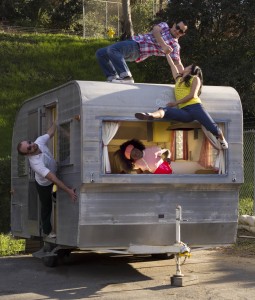 There is no formal audition process when it comes to choosing dancers. She trusts the recommendations given by her highly experienced Rehearsal Director Marisa Labog. She also meets dancers by word of mouth. “I love dancers with life experience; if they are too young, I feel that they haven’t lived enough. My dancers are eclectic, and it takes time to hone those qualities.”
There is no formal audition process when it comes to choosing dancers. She trusts the recommendations given by her highly experienced Rehearsal Director Marisa Labog. She also meets dancers by word of mouth. “I love dancers with life experience; if they are too young, I feel that they haven’t lived enough. My dancers are eclectic, and it takes time to hone those qualities.”
Duckler is also no stranger to constructive criticism from her patrons. She strongly believes that her work is thought provoking and offers many opportunities for a diverse audience to connect since the work is set in a unique and intimate space. “If you enjoy Los Angeles, music, and dance you can understand the work on so many levels. We performed From Time to Time’¦At the Oasis at a Krispy Kreme parking lot on Crenshaw, and people laughed’”even those not watching the show.” She notes the company’s expansion with enthusiasm: “We are going to Australia! I think it is going to be very interesting to take our work internationally and that excites me very much.”
As for the future of her company Duckler is a realist. She knows the unpredictability of the dance world but she is confident in what her company is producing. Duckler puts it best when she advises: “You have to follow your vision and see where it takes you. Be patient with yourself and find out what is the best thing for you.”
photos by Kaitlyn Pietras
From Time to Time’¦At the Oasis
Heidi Duckler Dance Theater
Fresno State, April 3. 2014
Cal State East Bay, April 9. 2014
Cal State Dominguez Hills, April 17. 2014
Cal State Los Angeles, April 29. 2014
for tickets and more info, visit www.heididuckler.org
